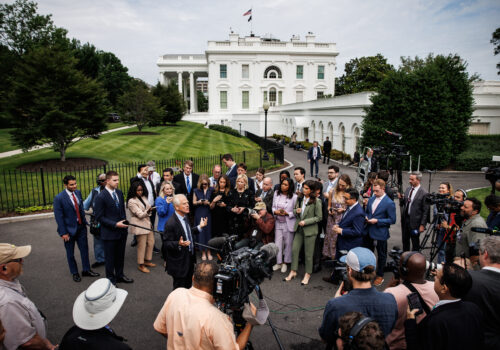The Trump administration recently imposed 10 percent tariffs on exports to the United States from many free-trade-agreement partners from Latin America. This has resulted in unnecessary instability. At a time when Washington should be deepening its economic engagement in the region, this measure risks undermining long-standing and strategically important partnerships. Colombia, Chile, Panama, and Peru are now urgently seeking exemptions to restore fair market access. So, too, are the CAFTA-DR nations Costa Rica, the Dominican Republic, El Salvador, Guatemala, and Honduras.
The White House has tied potential tariff relief to the elimination of tariff and nontariff barriers identified in the Office of the US Trade Representative’s 2025 National Trade Estimate Report on Foreign Trade Barriers (NTE Report). While the administration’s plan may be a well-intentioned attempt to increase US exports to the region in general, it overlooks a critical reality: Many of the so-called “barriers” are rooted in complex legal systems that cannot be easily dismantled without legislative or judicial processes. Pressuring countries to enact sweeping reforms in uncertain political environments could destabilize fragile democracies and weaken strategic partnerships, particularly at a time of growing global competition.
Profitable economic relationships
Despite ongoing challenges, Latin America has proven to be a successful economic partner for the United States. Washington enjoys trade surpluses with most Latin American countries that have existing agreements. According to US Census Bureau data, in 2024, US exports to CAFTA-DR nations totaled $47 billion, compared to $36.6 billion in imports.
Several examples illustrate this point. Colombia has consistently posted a surplus in industrial goods since 2012, driven by exports of machinery, vehicles, agrochemicals, and pharmaceuticals. Very recently, the United States has gained a trade surplus in agricultural goods with Colombia. Peru and Chile are also vital markets for US technology, medical equipment, and engineering services, due to their dynamic mining and agricultural sectors.
Moreover, many larger US companies have made significant investments across Latin America—investments made viable by the legal certainty that free trade agreements provide.
Complexity, not obstructionism
It is worth zeroing in on the “barriers” the White House aims to remove. The 2025 NTE Report outlines a variety of trade “barriers,” ranging from health policies to customs procedures. Yet many of these are embedded in domestic legal frameworks and cannot be removed through executive fiat. In Colombia, for example, lifting certain phytosanitary restrictions requires prior consultation with indigenous communities, as mandated by the country’s constitutional court. In the Dominican Republic, altering labeling or certification norms requires legislative action. In Honduras, reforms to intellectual property laws must pass through cumbersome legislatures facing intense social scrutiny.
These legal and institutional realities should not be viewed as roadblocks but as features of functioning democracies. The United States expecting immediate compliance is not only unrealistic; it risks backfiring.
Still, there are areas where progress can be swift and impactful. Many Latin American governments are already working to streamline health registration processes, modernize customs systems, and improve transparency in public procurement. For instance, Peru’s National Customs Superintendency has digitized import procedures, significantly reducing clearance times. Guatemala’s Ministry of Economy has pushed for regulatory alignment with international food safety standards, boosting trade efficiency.
These efforts reflect a clear political will to cooperate and offer the Office of the US Trade Representative a path to pursue measurable outcomes without demanding sweeping structural reforms upfront. Furthermore, these efforts are a clear message that FTA partners in the region are facilitating trade with the United States by avoiding unnecessary red tape procedures while also complying with WTO standards.
A strategic imperative: Latin America vs. Southeast Asia
Meanwhile, Southeast Asia is emerging as a strong competitor for US investment, bolstered by market-friendly reforms and frameworks such as the Indo-Pacific Economic Framework. Vietnam, Thailand, and other countries in the region are actively positioning themselves as preferred US trade partners in that part of the world, but with the caveat that none of them currently has an FTA with the United States.
There is no doubt, however, that China is wielding its geopolitical influence to use neighboring countries to export its goods to Latin America. From there, China takes advantage of the current network of trade pacts in Latin America to distort the rules of play of many products covered under FTAs. The triangulation of goods from third countries can often circumvent proper country-of-origin rules, undermine trade facilitation efforts in the region, and contribute to unfair trade practices.
US trade partners in Central and South America cannot afford to fall behind. The region’s comparative advantages—geographical proximity, shared legal traditions, integrated supply chains, and democratic values—are unmatched. Unlike Southeast Asia, Latin America shares a common geopolitical space with the United States, in addition to their shared economic security interests.
It is time for US stakeholders to fully recognize the strategic value of Latin American partners. Providing support for viable reforms, offering technical cooperation, and showing flexibility in tariff negotiations can help ease current trade tensions and solidify the US presence in a region where China is seeking to expand its influence.
Thankfully, an appropriate framework for institutional trade cooperation is already in place. These agreements don’t require reinvention—only thoughtful adjustment. To give one clear example, free trade commissions established under free trade agreements—such as CAFTA-DR and the free trade agreements with Colombia and Peru—play a critical role in ensuring adherence to agreed commitments and resolving disputes effectively and diplomatically. These bilateral committees, which offer the possibility of engaging separately in previous consultations with the private sector, provide a structured forum for addressing trade issues, implementing dispute resolution mechanisms, and updating the technical provisions of agreements as trade dynamics evolve.
Under CAFTA-DR, the committees have helped resolve disputes concerning agricultural market access and rules of origin. In the case of Colombia, the committee has facilitated dialogue on labor practices and sanitary barriers affecting US agricultural exports. With Peru, the committee has been instrumental in addressing environmental concerns, particularly those related to illegal logging.
By providing an institutionalized channel for engagement, these bodies help prevent diplomatic tensions and foster mutually beneficial outcomes, thereby enhancing stability and predictability in trade relations. The United States should look to make the most of these important committees.
In an increasingly fragmented global landscape, deepening ties with existing partners is the most direct and effective path to advancing US economic security and strategic interests. The best way to foster sustainable growth for US exports to the region is for the United States to seek predictable rules of engagement with its trading partners in the Western Hemisphere.
Enrique Millán-Mejía is a senior fellow for economic development at the Adrienne Arsht Latin America Center. He previously served as a senior trade and investment diplomat of the government of Colombia to the United States between 2014 and 2021.
Further reading
Wed, Jun 11, 2025
Economic pulse of the Americas: LAC’s economic outlook in mid-2025
Infographic By
This infographic asks the question: Where do Latin American and Caribbean economies stand halfway through 2025? As global trade tensions rise and economic uncertainty deepens, the region faces a shifting landscape—but also new opportunities.
Fri, May 30, 2025
Experts react: How the world is responding to the courtroom drama around Trump’s tariffs
New Atlanticist By
Several recent court rulings have complicated the US president's plans to impose sweeping tariffs—and US trading partners are watching.
Sun, Jun 15, 2025
Why tariffs on AI hardware could undermine US competitiveness
New Atlanticist By Joseph Webster, Jessie Yin
Tariffs targeted at China have their uses in the US-China tech competition, but they shouldn’t be applied haphazardly to US allies and partners.
Image: A US flag flutters near shipping containers as a ship is unloaded at the Port of Los Angeles, in San Pedro, California, U.S., May 1, 2025. REUTERS/Mike Blake/File Photo




